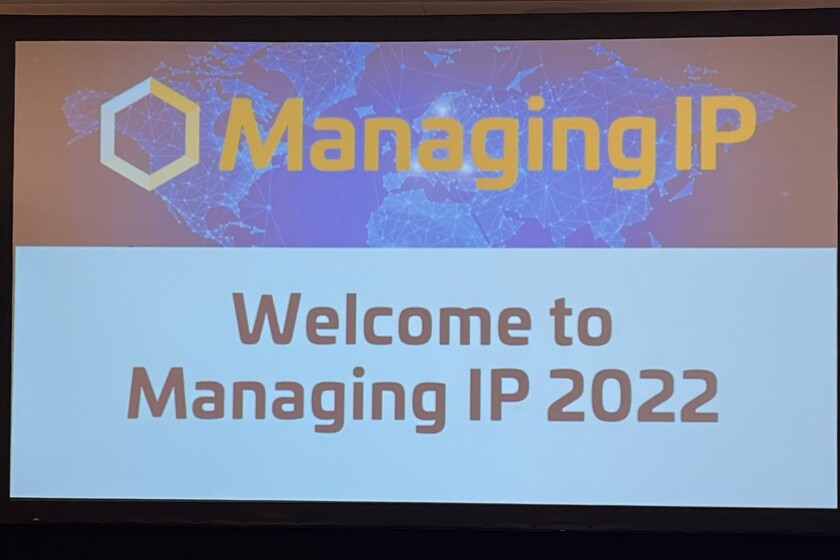Speakers delved into China’s recent legislative and policy changes in the intellectual property field and explored effective litigation strategies at the Managing IP Intellectual Property and Innovation Summit Europe on Wednesday, June 15.
Moderator Jamie Rowlands, partner at Gowling WLG in London, kickstarted the session by initiating a discussion on recent legislative and policy changes that affected IP owners in China. The conference, held in London, was Managing IP’s first in-person summit since March 2020.
There has been a big push towards IP, innovation, and technology in the country, noted Lucy Dugmore, head of East Asia policy at the UKIPO.
She pointed out that the introduction of the patent linkage system and an open licensing framework have been transformational. There have been important changes in the copyright, trademarks and designs domains as well.
The IP litigation environment has also improved because of changes to the statutory damages limit and the introduction of punitive damages, she added, noting: “China has a really active legal landscape at the moment.”
The CNIPA has also been pushing for improvements in the quality of the IP it grants, and reducing the timeframe for prosecution and contentious matters, Dugmore noted.
Enforcement challenges
George Sevier, head of IP enforcement, brands and licensing at Dyson in the UK, said that China was an important jurisdiction for most rights owners given that 23% of global manufacturing takes place there.
“Even if a company is not manufacturing in China, it needs to protect its IP to be able to prevent infringement,” he argued.
Initiating an action in China can often deliver mixed results, he said, though he sought to put this in context.
“Even though China gets the brunt of most criticisms, every jurisdiction and IP system has its problems.
“If you look at the US, it is the cost of the litigation, and if you look at Europe, it’s the time taken to conclude an action.”
In more positive news, he said, specialised judges heard cases in China and usually made the right decisions.
“The challenge is, however, the remedies. It is almost possible to prove damages because of evidentiary requirement of Chinese courts.”
Damages can be low, and courts can take a long time to make decisions, he added.
“Even though patent infringement cases in China can be wrapped up in six months, cases in which foreign litigants are involved often take three to four years to conclude.”
Sevier also highlighted that an average patent damage award in China was about RMB 500,000 ($75,000) – which was very low and not really a disincentive for infringement.
Other speakers also recognised that it could be difficult to obtain high damages in China.
Qinghong Xu, partner at Lung Tin Intellectual Property Agent in China, said it had been hard to get significant damages recently as the pandemic has made it difficult to collate evidence. She added, however, that it was not impossible.
In cases where courts have granted substantial damages, plaintiffs were able to produce information about the number of samples sold by defendants, sale prices and their profit margins, she noted.
If a plaintiff could collate similar strong evidence and the defendant could not prove that its profit margin was lower than that, a court would likely grant high damages, she said.
“If you ask for [RMB] 5 million in damages without meeting the initial burden of damages, that’s not going to be granted,” she added.
Delay tactics
Panellists also discussed strategies adopted by Chinese defendants to prolong actions.
For instance, Sevier highlighted, defendants in China almost always challenged the court’s jurisdiction. Chinese courts typically dealt with such issues within one to two months and usually rejected them.
After that, the defendant would challenge the validity of the relevant IP before the CNIPA, which would typically deal with this issue within five to six months.
But a court would usually refrain from issuing a decision until it heard back from the CNIPA, Sevier highlighted. And when the CNIPA dismissed the challenge, the defendant would usually appeal.
The court where the infringement action started sometimes waits for the appellate decision. But getting a second-instance ruling can take a couple of years, further delaying the original civil suit.
Defendants have also delayed suits by bringing actions, such as jurisdictional challenges, one after the other instead of concurrently, said Sevier.
He suggested that writing a letter to the appropriate authority requesting it to quickly deliver a decision usually speeded up the judgment delivery process.
Forum headaches
Panellists also discussed the pros and cons of initiating actions before different forums in China.
While the administrative courts in China were more proactive, they didn’t grant damages, said Sevier.
On the other hand, civil suits can take longer to conclude, though plaintiffs have a better chance of getting damages.
Xu said that her firm’s office had used a combination of administrative and judicial enforcement. It had often initiated administrative proceedings only to collate evidence for civil actions.
Choosing the right forum and jurisdiction is also critical, according to the speakers.
Administrative court judges often don’t have a strong technical background, said Sevier. “You don’t want them handling a very complex patent dispute.”
He added that forum shopping could be very tricky in China. While some authorities were very proactive, others weren’t, even though administrative actions in China were quite an attractive option.
“Administrative authorities can also be very unpredictable – you can get an unfavourable decision even in a very straightforward case,” he said.
Therefore, he suggested, being careful and talking to the authorities in advance might help litigants pick the right forum.
You can see more coverage from the conference here.











